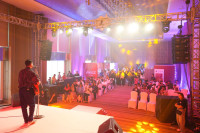Culture & Lifestyle
Influential marketing makes in-roads, but traditional advertising is still king
As social media audience and users grow, Nepali businesses are gradually setting aside a digital marketing budget.
Krishana Prasain
For a few days last week, dozens of Nepali celebrities posted videos on their social media accounts appearing to search for something. But that something also vaguely sounded like someone, as top celebrities like Nikita Chandak and Malina Joshi rummaged through their purses and cupboards looking for jigri.
On Friday, Nepali social media users found out what—or who—jigri was. It was a marketing ploy by Coca Cola to promote its new 250ml bottles of coke. The videos had begun surfacing about five days before the company launched its product on Friday. So what was the stunt all about? Marketing company officials said the international beverage company wanted to build anticipation among the social media followers of some of the most influential celebrities before rolling out the product.
“The main objective of the ‘Jigri’ campaign was to go viral,” says Nirnit Tandukar, operations manager at Uptrendly, an influencer marketing firm responsible for the soft drink’s social media campaign. The objective appeared to work, as hundreds of Nepalis took to social media platforms to comment on the videos.
Though influencer marketing is not a new concept, it’s recently gaining ground in Nepal, bringing endorsements from movie, music and social media celebrities to use their online platforms to advertise products. These testimonial advertising techniques, where the endorsers themselves pose as potential buyers, are fashioned in a way where the endorsements seem more like recommendations and less than advertisements. As the number of social media users continues to grow, digital marketing firms say influencer marketing is slowly making in-roads.
According to NapoleonCat, there are 9.3 million Facebook users and 1.2 million Instagram users as of June 2019. Social media marketing firms based in Kathmandu told the Post the number is slightly higher, 9.8 million active Facebook and Instagram users. According to Statcounter, an online traffic analysis tool, over 90 percent of those users are on Facebook and at least four percent are on YouTube.
One reason businesses may be open to an entirely new method of marketing in the country could be the cost compared to traditional ways, like hoarding boards, broadcast and print media advertising.
According to digital marketing agencies, an influencer’s tariff for advertising starts anywhere from Rs50,000 while a print advertisement in leading national dailies—they still command a prominent reach and audience—costs Rs100,000 or more.
Digital marketing spending, or more particularly social media marketing and influencer marketing, make up for a tiny piece of the national advertising spending, which is still dominated by traditional outlets.
According to the Advertising Association of Nepal, the share of digital advertising out of the overall advertising marketing—this includes print, television, radio and other traditional media—has doubled from 5 percent to 10 percent in the last two years.
By comparison, in neighbouring India, the digital advertising expenditure contributes to 17 percent of the total spending. A recent report by a London-based digital marketing firm says it expects India’s digital advertising spend to grow 32 percent in the next two years.
Tandukar says digital advertising is seeing signs of growth in Nepal as well. In the past year alone, Tandukar says Uptrendly’s business has grown sixfold.
“Nepali brands are starting to separate a certain chunk of their budget for digital marketing,” he says. “Businesses are now aware that social media users have been growing exponentially.”
Anuj Shrestha, co-founder at Lone Tree, a digital marketing agency based in Kathmandu, says influencer marketing benefits from the trust the audience has on celebrities, its cost-effectiveness, and reaching the targeted audience. But he is quick to admit that it is still in its nascent stage.
“In Nepal, there are very few celebrities with millions of followers or even dedicated followers. So, the market is still comparatively small,” he says.
Shrestha says that the influencer has been charging a price per impression—an advertiser agrees to pay per 1,000 views of a single advertisement—or on a contract basis, which could be any number of posts.
“The mode of payment and choice of influencers depends on the client’s budget and our negotiations with the celebrity influencers,” he says.
One of the popular Nepali social media account, Routine of Nepal Banda, has 497,000 followers on Instagram and one million followers on Facebook. Victor Poudel, the person behind the account, says he has been receiving offers to promote a number of products—both from marketing agencies and directly from brands—on a regular basis.
“I have individual contracts with different brands and agencies depending on the posts I am required to produce and post,” Poudel says.
But as influential marketing grows and receives visibility among the Nepali audience, many social media users have also criticised influencers for failing to clarify these posts as paid promotions or genuine recommendations for which they don’t receive benefits.
Tandukar says Uptrendly recommends the influencers to use hashtags #uptrendly and #paidpromotion whenever they are commissioned for any advertising campaigns. But among three posts for Coca Cola’s ‘Jigri’ campaign by Nikita Chandak and Malina Joshi, only one carried these hashtags.
“Being an influencer is a huge responsibility because you have to respect your followers,” says Subeksha Khadka, a former Miss Nepal. But unlike Chandak and Joshi, all three posts on ‘Jigri’ campaign on her Instagram feed do not carry the hashtag #paidpromotion.
Khadka has 215,000 Instagram followers and has been endorsing products and services through her social media accounts. Although none of her posts clarifies whether they are genuine endorsements or advertisements, she insists that she only endorses products she personally uses.
“Many of my female followers ask me about the type of cosmetics I use so, I work with brands I have been personally satisfied with,” she says. She still gets paid for them.
Ramesh Danekhu, assistant manager for corporate communication and marketing at Morang Auto Works, says as an avid follower of some of the Nepali celebrities on social media platforms, the chances of him being influenced by celebrity endorsements is higher than any other generic advertisements in traditional media.
“I religiously follow Nikita Chandak and I am at least drawn to her endorsements,” he says. “It’s like a friend making recommendations to me.”




 11.12°C Kathmandu
11.12°C Kathmandu













%20(1).jpg&w=300&height=200)

